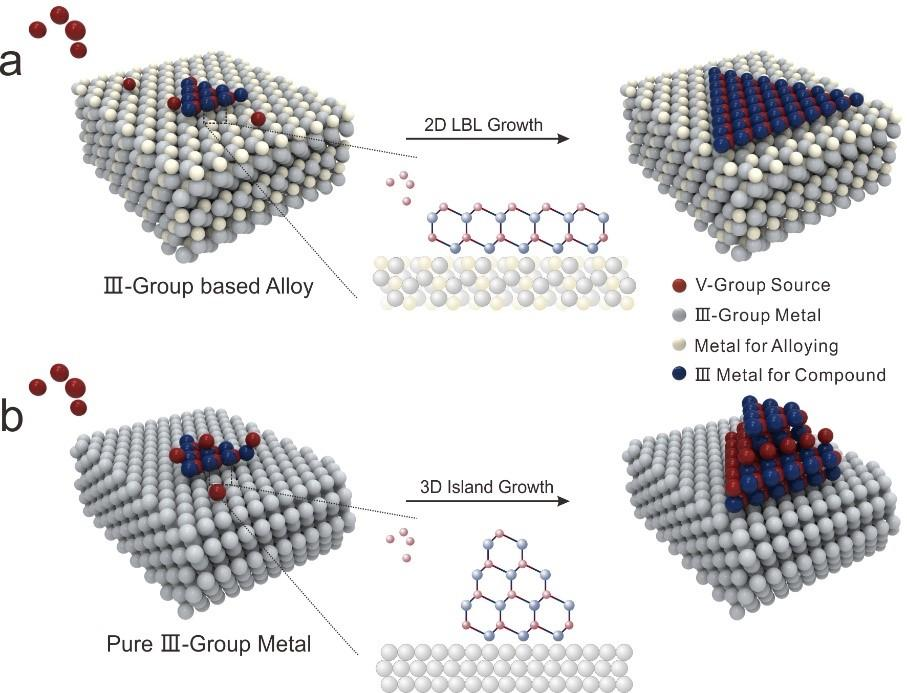On August 7, Nature Communications published an article on the latest research findings by Prof. Fu Lei. Fu’s team proposed a strategy to stimulate the anisotropic growth of various representative non-layered III–V single crystals through enhancing the interfacial interaction between the III–V crystals and the growth substrates, and realize the universal growth of ultra-thin III-V semiconductor single crystals.
The article, entitled Universal Growth of Ultra-Thin III-V Semiconductor Single Crystals, has Wuhan University named as the first author affiliation. Zeng Mengqi (associate research fellow), Chen Yunxu and Liu Jinxin (PhD students of the class of 2017), from the School of Chemistry and Molecular Sciences, are co-first authors. Prof. Fu Lei is the corresponding author. Their research has been strongly supported by the National Natural Science Foundation of China and the Sino-German Center for Research Promotion.
III-V semiconductors have profound underlying physics, such as high charge carrier mobility, high electron drift velocity, efficient light detection and emission, which endow them great potential to be applied in various electronics and optoelectronics devices. two-dimensional III-V semiconductors show many unique properties, such as enlarged lattice constant, blue-shifted bandgap, and strong electron–hole interaction, etc. (e.g. GaN), which will further enhance its application potential. However, besides two-dimensional GaN, the effective preparation of other ultra-thin III-V single crystals, such as GaP, InP, and InSb, has not yet been synthesized. The current methods used to grow two-dimensional GaN rely heavily on a nanoscale confined space or a predesigned template, thus seriously restricting the expansion of the growth methods to other two-dimensional III-V single crystals. Therefore, it is important to develop a general strategy to enable the growth of these ultra-thin III–V systems.

▲Schematic illustration of the universal growth of ultra-thin III-V semiconductor single crystals
Prof. Fu Lei’s team has been committed to the precise synthesis of two-dimensional atomic crystals (website of Fu Lei’s research group: http://leifu.whu.edu.cn), and has developed a set of methods to synthesize two-dimensional atomic crystals based on the liquid metal system. In the research, Fu’s team used III-group liquid metals (Ga, In) as precursors, dissolving them with specific transition metals (such as Au) to form alloys (such as AuIn2, AuGa) as the growth substrates. The strong interfacial interaction between the alloy substrates and targeted III-V crystals is utilized to activate the layer-by-layer growth mode of the crystals, thereby realizing the two-dimensional anisotropic growth of the single crystals. Based on this, the team has grown representative ultra-thin III-V semiconductor single crystals, including InSb, GaSb, InP, GaP, GaN and other crystals whose band gap ranges from ultra-narrow band gap to wide band gap. Such a strategy of designing the interfacial interaction between the substrate and the crystal to adjust the crystal growth mode blazes a universal trail for realizing the two-dimensional anisotropic growth of various crystals.
In addition, the team also found that those high-quality ultra-thin single crystals exhibit fascinating properties of strong phonon confinement, salient band gap shift and excellent nonlinear optical properties, which provides a promising platform for other researchers to explore the intrinsic physical and chemical properties of ultra-thin III-V semiconductors.
The research has been supported by multiple research institutions: Prof. Gao Junfeng’s team from Dalian University of Technology provided theoretical calculation support for the interaction between substrates and crystals while researcher Wang Zhongchang’s team from the Portuguese International Iberian Nanotechnology Laboratory (INL) characterized the structure of the samples using a high resolution scanning transmission electron microscope (TEM) with spherical correction.
Link to the paper: https://www.nature.com/articles/s41467-020-17693-5
Written by Hua Yuan
Rewritten by Wu Xingwen
Edited by Wu Buer, Sylvia and Hu Sijia